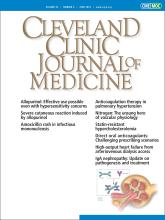Article Figures & Data
Tables
Type Orders Respiratory Oxygen management
Oxygen device: [eg, nasal cannula]
Flow
Target SpO2 rangeLaboratory tests General prognostic markers for COVID-19a
C-reactive protein
D-dimer
Ferritin, blood
Lactate dehydrogenase
General labs and cultures
Complete blood cell count with differential
Complete metabolic panel
Lupus anticoagulant, plasma
Magnesium, blood
Phosphorus, inorganic
Procalcitonin
Prothrombin time and International Normalized Ratio
Activated partial thromboplastin time
SARS-CoV-2
Rapid polymerase chain reaction assay for influenza and respiratory syncytial virus
Urinalysis with microscopic examination, reflex culture
Blood culture x 2 panel (STAT Lab Collect)
Cardiac prognostic markers for COVID-19b
High-sensitivity troponin T for 5 days
N-terminal pro-B-type natriuretic peptide
Creatine kinase
Creatine kinase MB fraction only
Imagingc Chest radiograph 2 views (front and lateral)
Chest radiograph 1 view (front, portable)Cardiology Electrocardiography ↵a Inflammatory markers (ferritin, lactate dehydrogenase, D-dimer, C-reactive protein) may be tracked daily or every other day initially.
↵b Severely elevated cardiac markers, without acute ischemic changes on an electrocardiogram, suggest inflammatory injury rather than acute coronary syndrome.
↵c Portable imaging is preferred to reduce caregiver exposure.
If D-dimer is < 3,000 FEU or unknown, and:
No renal impairment: enoxaparin 40 mg every 24 hours
Creatinine clearance 10–30 mL/hour: enoxaparin 30 mg every 24 hours
Creatinine clearance < 10 mL/hour, acute kidney injury, or dialysis: heparin 5,000 units every 12 hours
If D-dimer is ≥ 3,000 FEU or critically ill patient (independent of D-dimer level), and:
No renal impairment: enoxaparin 40 mg every 12 hours
Creatinine clearance 10–30 mL/hour: enoxaparin 40 mg every 24 hours
Creatinine clearance < 10 mL/hour, acute kidney injury, or dialysis: heparin 7,500 units every 12 hours
- TABLE 3
Summary of treatment recommendations for patients with COVID-19 at Cleveland Clinic
Mild to moderate illness (no hypoxia, no radiographic pneumonia, oxygen saturation (SpO2) > 94% on room air)
Supportive careSevere illness (hypoxia [SpO2 < 94% on room air], radiographic evidence of pneumonia, not critically ill)
Supportive care
Dexamethasone
Remdesivir
Infectious disease consult
Possibly emerging therapies
Possible enrollment in clinical trialsCritically ill (mechanically ventilated)
Dexamethasone
Remdesivir
Infectious disease consult
Possibly convalescent plasma (in the context of a clinical trial)
Possibly emerging therapies
Possible enrollment in clinical trialsImmunosuppressed patients
Consider reduction in immunosuppression in conjunction with rheumatology or oncology consultant
Dexamethasone
RemdesivirPregnant patients
As above, consider risks and benefits of glucocorticoids and remdesivir






